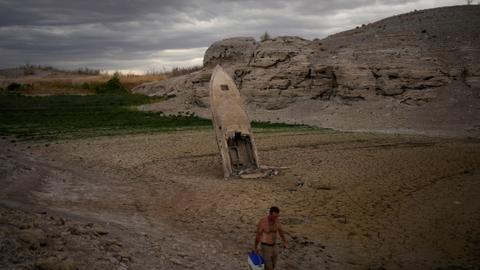
Arizona and Nevada states and neighbouring Mexico will have water supplies reduced for a second straight year, with allocation falling 21% for Arizona, 8% for Nevada and 7% for Mexico, officials say.

Some western US states and Mexico must cut water usage to avoid a "catastrophic collapse" of the Colorado River, Washington officials have said as a historic drought bites.
Despite years of warnings, states that depend on the river have not managed to reduce their demands enough, and on Tuesday, the federal government said it was imposing cuts.
"Water use in the Basin must be reduced," said Tanya Trujillo, Assistant Secretary for Water and Science at the Interior Department.
Arizona's allocation from the river will fall by 21 percent in 2023, while Nevada will get eight percent less. Mexico's allotment will drop by seven percent.
Negotiations over further reductions are creating tension among the states, especially as California, the largest user, has so far avoided cuts triggered by low reservoir levels.
California, the biggest user of the river's water and the most populous of the western states, will not be affected next year.
More than two decades of well below-average rainfall have left the river, the lifeblood of the western United States, at critically low levels, as the human-caused climate crisis worsens the natural drought cycle.
READ MORE: Californians use more water as drought worsens in US state
Reduced rain and higher temperatures
The Colorado River rises in the Rocky Mountains and snakes its way through Colorado, Utah, Arizona, Nevada, California and northern Mexico, where it empties into the Gulf of California.
It is fed mainly by snow caps on mountains at high altitudes, which melts slowly throughout the warmer months.
Scorching temperatures and reduced melting snow in the spring have lowered the water volume flowing from the Rocky Mountains, where the river originates before it snakes 2,334 kilometres southwest and into the Gulf of California.
As a consequence, there is not as much water in the river which supplies tens of millions of people and countless acres of farmland.
Federal officials asked for reduced usage of 2 to 4 million acre-feet of water per year, a reduction of 15 percent to 30 percent in the coming year.
Because the states failed to respond to a federal ultimatum to figure out how to cut their water use, they could face even deeper cuts that the government has said are needed to prevent reservoirs from falling so low they cannot be pumped.
Bureau of Reclamation Commissioner Camille Touton said the additional 15 percent reduction is necessary to ensure that water deliveries and hydroelectric power are not disrupted.
She emphasised the partnership between federal officials and their counterparts in the seven states and Mexico but repeatedly declined to say how much time the states will have to reach the deal she requested in June.
Hydrodams at risk
For years, cities and farms have consumed more water from the river than what flows through it, depleting its reservoirs and raising questions about how it will be divided as water becomes more scarce.
The water level at Lake Mead, the nation's largest man-made reservoir, has plummeted so low that it's currently less than a quarter full and getting dangerously close to a point where not enough water would flow to produce hydropower at the Hoover Dam on the Nevada-Arizona border.
Already, extraordinary steps have been taken this year to keep water in Lake Powell, the other large Colorado River reservoir, which sits upstream of Lake Mead and straddles the Arizona-Utah border. Water from the lake runs through Glen Canyon Dam, which produces enough electricity to power between 1 million and 1.5 million homes each year.
After water levels at Lake Powell reached levels low enough to threaten hydropower production, federal officials said they would hold back some water to ensure the dam could still produce energy. That water would normally flow to Lake Mead.
READ MORE: California warns of water cuts as drought worsens in western US
Source: TRTWorld and agencies
Source https://www.globalcourant.com/western-us-mexico-hit-with-water-cuts-as-drought-bites/?feed_id=11862&_unique_id=62fc2a6eb85f6

Post a Comment